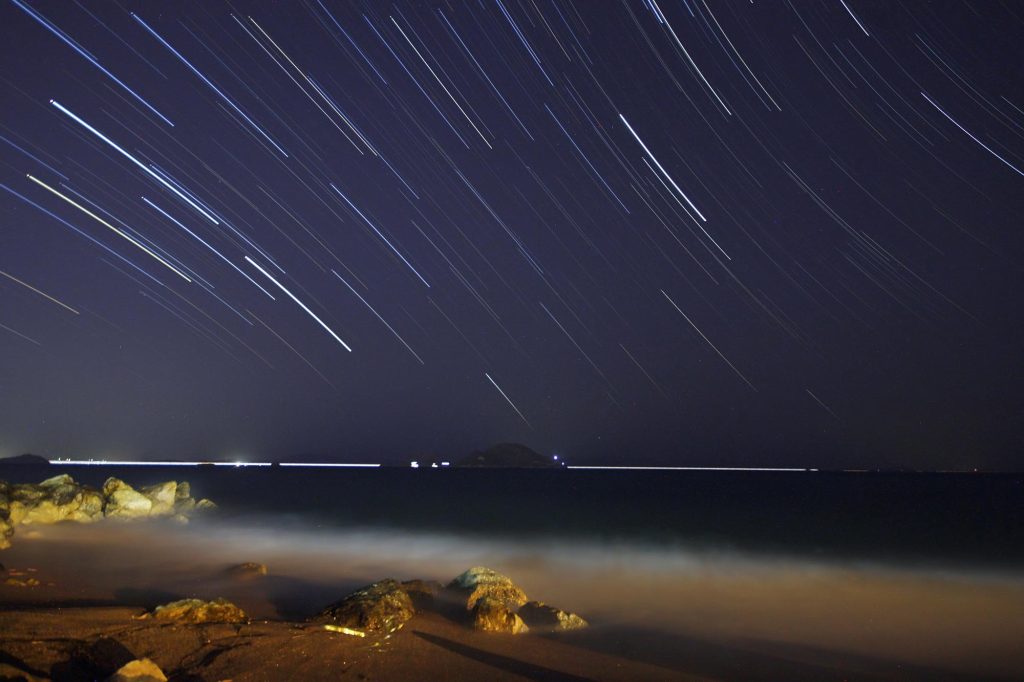
غالبًا ما تجلب واحدة من أكثر زخات النيازك السنوية وضوحًا في سماء الأرض ليلاً ، وستبلغ ذروتها في 12 و 13 أغسطس. عادةً ، تقدم 50-100 “شهاب” في الساعة في أوجها ، مما يجعلها عرضًا مثيرًا للإعجاب. هناك مشكلة واحدة فقط هذا العام: اكتمال القمر.
وقال “للأسف ، ذروة بيرسيدس هذا العام ستشهد أسوأ الظروف الممكنة للمراقبين”[{” attribute=””>NASA astronomer Bill Cooke, who leads the Meteoroid Environment Office at NASA’s Marshall Space Flight Center in Huntsville, Alabama. “Most of us in North America would normally see 50 or 60 meteors per hour,” he said, “but this year, during the normal peak, the full Moon will reduce that to 10-20 per hour at best.”
Because the Moon is so much brighter than anything else in the night sky, it will wash out all but the very brightest Perseids as they streak through our atmosphere and burn up far overhead.

A shower of Perseid meteors lights up the sky in 2009 in this NASA time-lapse image. Credit: NASA/JPL
As the full Moon subsides, the Perseids will begin to weaken around August 21-22 and cease completely by September 1. They’re the debris remnants of Comet Swift-Tuttle, a lumbering “snowball” composed of ice, rock, and dust, which orbits our Sun every 133 years. The comet itself was last visible to us in 1992 and won’t pass our way again for over 100 years: not until 2125.
How far back sightings of the Perseids actually go remains a matter of some disagreement, Cooke said. The comet itself wasn’t identified until 1862, but the meteor shower was seen over medieval Europe. The annual event came to be known as “the Tears of St. Lawrence,” named for the last of seven Roman church deacons martyred by the emperor Valerian in August of the year 258.
So, while this is probably not the best year to make a special trip in order to see the Perseids, if you find yourself outside between midnight and dawn on August 13, don’t forget to look up anyway. Because you never know – you might just catch one of the bright Perseid meteors that defies the glare of the Moon. Also, be aware that the occasional early Perseid can streak across the sky as much as a week beforehand.
If you want to know what else is in the sky for August 2022, check out the latest “What’s Up” video from Jet Propulsion Laboratory:
https://www.youtube.com/watch؟v=whU7pd7bfyg
ما هي بعض المعالم البارزة في مراقبة السماء في أغسطس 2022؟ ينتهي العرض اليومي لأربعة كواكب بالعين المجردة في الصباح هذا الشهر. ولكن لا يزال هناك الكثير من الميزات الرائعة ، خاصة إذا كان لديك وصول إلى مناظير. زائد،[{” attribute=””>Saturn and Jupiter are returning to nighttime skies! The outlook for the Perseid meteors isn’t great due to a full moon on the peak night of August 12, but still it’s worth keeping an eye out for early Perseids after midnight the week before. And August is a great month to learn an easy-to-spot constellation – Cygnus the swan.

“متعطش للطعام. طالب. متحمس محترف للزومبي. مبشر شغوف بالإنترنت.”






More Stories
صاروخ فالكون 9 التابع لشركة سبيس إكس يتوقف قبل إطلاقه ملياردير في مهمة خاصة
بقرة بحرية ما قبل التاريخ أكلها تمساح وسمكة قرش، بحسب حفريات
إدارة الطيران الفيدرالية تطلب التحقيق في فشل هبوط صاروخ فالكون 9 التابع لشركة سبيس إكس